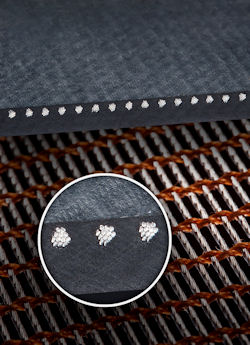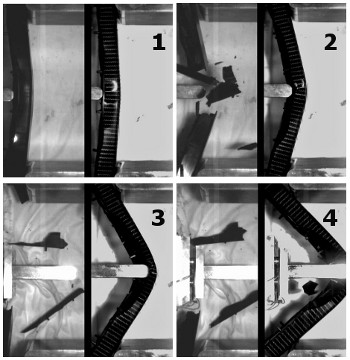 |
| December 18, 2012 | Volume 08 Issue 47 |
Designfax weekly eMagazine
Archives
Partners
Manufacturing Center
Product Spotlight
Modern Applications News
Metalworking Ideas For
Today's Job Shops
Tooling and Production
Strategies for large
metalworking plants
The tough get tougher:
Plastic parts can now be injection molded with steel cord reinforcement

BASF and partners have been working on perfecting plastic parts that are injection molded with steel cord reinforcement. Steel cord fabrics ensure the integrity of a lightweight part, even when subjected to the high impact energy of a crash.
Together with its partners Bekaert (Belgium) and voestalpine Plastics Solutions (Netherlands), BASF is working on perfecting thermoplastic components that are reinforced with steel cord fabrics and produced by injection molding. The three companies have joined together to further develop Energy Absorption, Safety, and Integrity (EASI) technology with partners in the automotive industry.
For auto manufacturers, especially, the development could be a step forward in the lightweighting of more-effective crash-protection components. A first for the industry, the technology creates an entirely new performance class of materials.
In contrast to known types of reinforcements like continuous fiber-reinforced laminates or other carbon or glass fiber fabrics, the steel cord inserts are big boosts to the integrity of the molded part's function in a crash situation.
New concept using steel cord
BASF and its partners have been investigating steel cord-reinforced injection molded parts as a team since 2010, although the first production part using a predecessor technology was developed years before. That process was based on compression molding with GMT (glass mat reinforced thermoplastics), and it garnered Quadrant Plastic Composites, voestalpine Polynorm, and Bekaert the AVK (German Federation of Reinforced Plastics) Innovation Award in 2008 for creating a steel-reinforced composite that could meet crash impact requirements up to 50 mph. According to a Quadrant press release at that time, "The new composite not only opens up new types of applications in the automotive sector, hitherto reserved for metals, but also permits a higher level of functional integration and freedom of design than steel. Through the targeted use of steel cord-reinforced GMT/GMTex, weight reductions of up to 30% can be achieved when compared with conventional solutions."
In this latest cooperative effort, Bekaert contributes its expertise in the manufacture of steel cord fabrics, while voestalpine Plastics Solutions is responsible for the processing technology and part production in injection molding.

In contrast to traditional types of plastic reinforcement on the market (left side), steel cord fabrics (right side) ensure the integrity of a part even when subjected to the high impact energy of a crash. You can watch the full video of this impressive test of a steel-reinforced plastic part by clicking here.
BASF, for its part, is continuing to develop its crash-optimized short or long fiber-reinforced polyamide specialties in the Ultramid product line for use in combination with the steel cord inserts. At the same time, the company is expanding its expertise in the prediction of part performance by enhancing the capabilities of its Ultrasim simulation tool through incorporation of representation methods and material models for the new composite materials. By using polyamide as matrix material, it is not only possible to create attached or semi-structural parts but also body-in-white (BIW) components, which need to run through the e-coating process.
Injection molding and steel cord reinforcement
The steel cord reinforcement employed in the EASI concept ensures that an injection molded part retains its structural integrity. While EASI parts may be damaged in a crash, they are still able to absorb energy and lead it further into the structure. This is a decisive innovation when compared to molded plastic parts with conventional reinforcement that usually fracture upon failure, so the material is predestined for regions that are intended for absorption and harmonic distribution of crash energy (see slow-motion still-picture sequence above or full Microsoft Player video at www.plasticsportal.eu/ultramid-steelcord).
According to BASF, the level of performance using this material cannot be attained with other types of reinforcing technology (although the company has not released its own material performance specs for the technology). Vehicle components where these characteristics can be exploited include structure-relevant attachments such as bumper beam carriers or front ends as well as BIW components.
Injection molding of thermoplastics such as Ultramid permits even complex shapes to be produced easily. The real bonus is that the process is an established, highly automated plastic processing method for high-volume production. The three companies are betting that combining polyamide injection molding and steel cord reinforcement provides optimal qualities to parts that must retain their supporting function and structural integrity in order to further distribute forces in a crash.
Source: BASF
Published August 2012
Rate this article
View our terms of use and privacy policy
